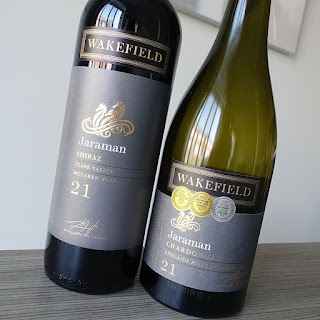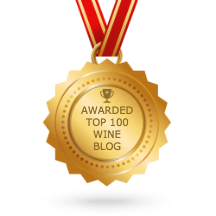red wine review is a delicious, premium Australian Shiraz. It is a relatively frequent visitor to the LCBO, with a new batch of this 2022 vintage arriving most recently in the LCBO VINTAGES New Release Collection.
Wakefield Wines was established in 1969 by Bill Taylor Sr. and his two sons. Known locally in their homelands of Australia as Taylors Wines, the family's goal was to establish an estate winery, and eventually settled on a site by the Wakefield River in South Australia's Clare Valley.
As a founding member of Australia's First Families of Wine, Wakefield continues to be led by the third generation of the Taylor family - brothers Mitchell, Justin, and Clinton, the sons of Bill Taylor and grandchildren of Bill Taylor Sr. Together, the brothers continue their family tradition of crafting delicious wines that stand the test of time, while also firmly fixed upon the future and the next generation. The family's philosophy is to craft wines sustainably and responsibly, while respecting the fruit and where it comes from. The goal at Wakefield is to be Australia's best wine company at applying best practices and principles in environmental management to enhance sustainable business activities and products. They favour the most innovative techniques to improve energy efficiency, water conservation, and packaging, while also preventing or eliminating waste and pollution.
This Shiraz is from the Taylor family's Jaraman range of wines, which celebrates Australia's iconic wine regions and provides great diversity. With the Jaraman range, the Taylor family searches for parcels of extraordinary fruit to craft wines that showcase their distinctive regional characteristics and style. Each vintage, the fruit for wines in the Jaraman range are sourced from celebrated Australian wine regions that are renowned for the particular variety. There are several wines in the Jaraman range - Cabernet Sauvignon, Pinot Noir, and Chardonnay - in addition to this Shiraz. At the winery, the winemakers ensure that the distinct regional characteristics of each grape are preserved and enhanced, with the fruit as the star and any winemaking influencing the supporting act. With the Jaraman range, the wines showcase the skill and dedication of their winemakers and their philosophy of respecting the fruit.
The 2022 vintage of this Shiraz is crafted with fruit from both Clare Valley (72%) and McLaren Vale (28%), in South Australia. It was vinified using traditional methods, with parcels from the two regions kept separate until blending, prior to oak ageing. The wine was matured for an average of 12 to 15 months in a selection of new and used American oak hogsheads before being bottled.
In Clare Valley, the 2022 growing season was a year of both high quality and quantity as the crops basked in the mild, sunny days without any rain or humidity. With stunningly beautiful and uninterrupted weather in the Clare Valley, the grapes blossomed under idyllic conditions. In McLaren Vale, the growing season featured mild conditions of warm days and cool nights, with minimal rain and no heat spikes. However, inconsistent fruit set in McLaren Vale reduced yields by about 15%. The story of the vintage between these two renowned wine regions helps explain the final blend.
I last enjoyed this 2022 Wakefield Jaraman Shiraz back in December and am curious to see how it has evolved over the last 6 months...
Screw cap enclosure. The medium-high intensity nose is fresh and open with lovely dark fruit, blackberry, peppery spice, and cool minty herb aromas balanced with savoury oak, earth, plum, and a touch of woodspice. The ripe, medium+ bodied palate is dry with blackberry, dark berry, and savoury oak flavours alongside minty herbs, wood spice, plum, and black pepper notes. It has fresh and juicy acidity, alongside smooth and refined tannins, with good structure. Blackberry, plum, savoury oak, chocolate, black pepper, mocha chocolate, and earth notes linger on the crisp, long-lasting finish. This recommended buy should drink nicely over the next 5-7 years. Score: 89 pts
A wide selection of Wakefield Wines are available at the LCBO, while the full range can be ordered from their Agent - Profile Wine Group.
Wakefield Wines was established in 1969 by Bill Taylor Sr. and his two sons. Known locally in their homelands of Australia as Taylors Wines, the family's goal was to establish an estate winery, and eventually settled on a site by the Wakefield River in South Australia's Clare Valley.
As a founding member of Australia's First Families of Wine, Wakefield continues to be led by the third generation of the Taylor family - brothers Mitchell, Justin, and Clinton, the sons of Bill Taylor and grandchildren of Bill Taylor Sr. Together, the brothers continue their family tradition of crafting delicious wines that stand the test of time, while also firmly fixed upon the future and the next generation. The family's philosophy is to craft wines sustainably and responsibly, while respecting the fruit and where it comes from. The goal at Wakefield is to be Australia's best wine company at applying best practices and principles in environmental management to enhance sustainable business activities and products. They favour the most innovative techniques to improve energy efficiency, water conservation, and packaging, while also preventing or eliminating waste and pollution.
This Shiraz is from the Taylor family's Jaraman range of wines, which celebrates Australia's iconic wine regions and provides great diversity. With the Jaraman range, the Taylor family searches for parcels of extraordinary fruit to craft wines that showcase their distinctive regional characteristics and style. Each vintage, the fruit for wines in the Jaraman range are sourced from celebrated Australian wine regions that are renowned for the particular variety. There are several wines in the Jaraman range - Cabernet Sauvignon, Pinot Noir, and Chardonnay - in addition to this Shiraz. At the winery, the winemakers ensure that the distinct regional characteristics of each grape are preserved and enhanced, with the fruit as the star and any winemaking influencing the supporting act. With the Jaraman range, the wines showcase the skill and dedication of their winemakers and their philosophy of respecting the fruit.
The 2022 vintage of this Shiraz is crafted with fruit from both Clare Valley (72%) and McLaren Vale (28%), in South Australia. It was vinified using traditional methods, with parcels from the two regions kept separate until blending, prior to oak ageing. The wine was matured for an average of 12 to 15 months in a selection of new and used American oak hogsheads before being bottled.
In Clare Valley, the 2022 growing season was a year of both high quality and quantity as the crops basked in the mild, sunny days without any rain or humidity. With stunningly beautiful and uninterrupted weather in the Clare Valley, the grapes blossomed under idyllic conditions. In McLaren Vale, the growing season featured mild conditions of warm days and cool nights, with minimal rain and no heat spikes. However, inconsistent fruit set in McLaren Vale reduced yields by about 15%. The story of the vintage between these two renowned wine regions helps explain the final blend.
I last enjoyed this 2022 Wakefield Jaraman Shiraz back in December and am curious to see how it has evolved over the last 6 months...
Tasting Note:
WAKEFIELD JARAMAN SHIRAZ 2022 - Clare Valley / McLaren Vale, South Australia (#377036) (XD) - $24.95Screw cap enclosure. The medium-high intensity nose is fresh and open with lovely dark fruit, blackberry, peppery spice, and cool minty herb aromas balanced with savoury oak, earth, plum, and a touch of woodspice. The ripe, medium+ bodied palate is dry with blackberry, dark berry, and savoury oak flavours alongside minty herbs, wood spice, plum, and black pepper notes. It has fresh and juicy acidity, alongside smooth and refined tannins, with good structure. Blackberry, plum, savoury oak, chocolate, black pepper, mocha chocolate, and earth notes linger on the crisp, long-lasting finish. This recommended buy should drink nicely over the next 5-7 years. Score: 89 pts
A wide selection of Wakefield Wines are available at the LCBO, while the full range can be ordered from their Agent - Profile Wine Group.




































